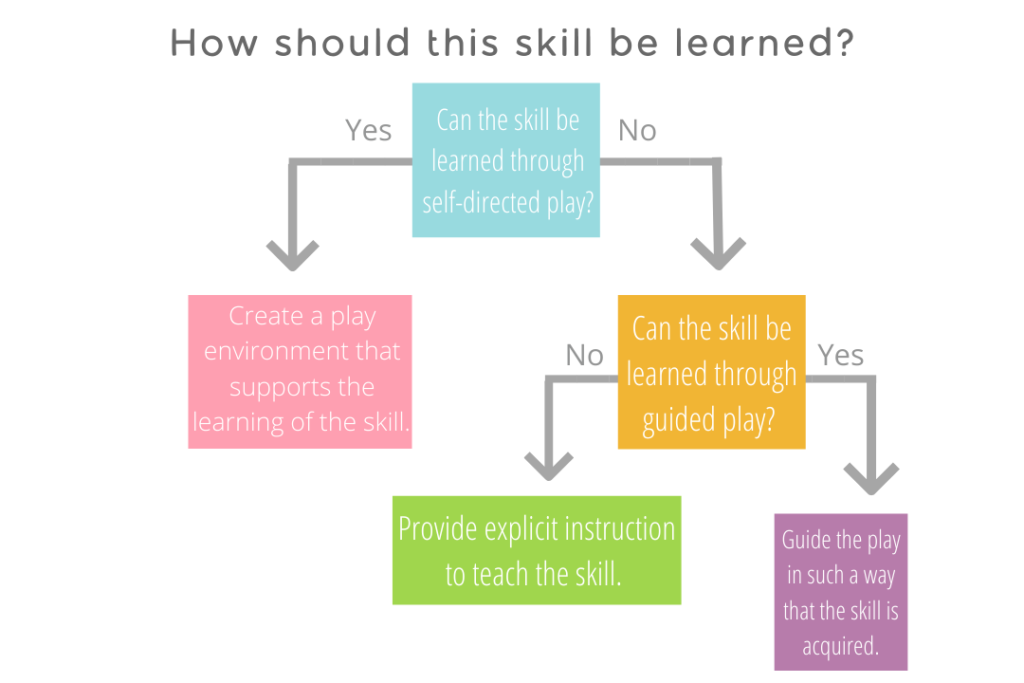*Note that I use the terms direct instruction and explicit instruction interchangeably in this article. I am not referring to the scripted practice of direct instruction, but rather implying that direct or explicit instruction is teacher-led and specific.
I’m a big advocate for play and play-based classrooms. Research has shown time and time again that play is the best way for children to learn. But, I’ll admit that I feel a little uncomfortable with the idea that if we take a completely hands-off approach and just let children play and explore on their own all day long they will simply absorb everything they need to learn. Teachers play a big role in planning an environment that will maximize learning through play–play-based classrooms require a lot of work behind the scenes. Teachers also need to be aware of what skills are going to require more explicit instruction and be willing to take opportunities to provide that.

I recently heard the analogy that if you put a toothbrush and toothpaste in a child’s environment, but wait for them to discover and explore it completely on their own, they aren’t likely to come away from the experience with the knowledge they need to keep their teeth clean and healthy. Even if they were taught once specifically how to brush their teeth thoroughly, they will still need lots of guidance and help before they are ready to be fully independent.
While there are many, many things that children will learn simply by watching them modeled or through self-discovery, there are also many things that they need direct instruction for in order to gain a full understanding. In general, during the preschool years, direct instruction should be used sparingly, with self-directed or guided play taking the superior role. Research shows that “discovery-based guided play actually results in increased learning for all children relative to both free play and direct instruction” (see Alferi et al. 2011). If a concept or skill can be taught well through play, that is how it should be done. If it can’t, then a more explicit form of teaching may be appropriate.
How, then, do we know when it’s time to step in and offer more explicit instruction? Ask yourself these questions:

Let’s take one of the primary academic items many teachers introduce in preschool–letters. What they look like, how to write them, what sounds they make….these are all concepts that are going to require more direct instruction than just having them in the environment for children to see. Much like the toothbrush example, we can’t fill a room with books and word walls and expect that kids will eventually learn to read and write because they have so many letters and words in their surroundings.
During play, children should be given ample opportunities for writing. Their scribbles will begin to refine over time and turn into lines and curves that resemble letters. Because print is a part of their natural environment, they have an awareness that there is a structure and organization to how all of these symbols come together in a meaningful way. Their natural exploration will lead them to start to pull their knowledge together in ways that make sense. That said, the time will come when more formal writing instruction is appropriate.
Because letter formation is important for later writing success, the majority of students are going to require some degree of direct instruction to learn how to write each letter (if your students are like mine, writing from the bottom up seems be to the default prior to any teacher-led instruction). Once the direct instruction is provided and understanding is demonstrated, you should move back into the realm of play to reinforce the skill–set up the play environment to encourage continued writing practice.
A logical approach when teaching how to write a new letter would be to ask the question “Can the child learn to properly write the letter S during self-directed play?” The students may make attempts to copy letters they’ve seen in their environment during self-directed play, but they may or may not attempt the letter S, and it is not likely that they would be aware of exactly how to form the letter. In most instances, the answer to this question would be ‘no’.
“Can the child learn to properly write the letter S during guided play?” The answer here may be more nuanced. If you were to repeatedly model how to write the letter S during guided play, some children may pick up on the proper formation. You might attempt to teach the skill during guided play and see how it is received. If you do not find that the students are picking up on the skill in this way, you would move to the next level of support.
Over time, you’ll know easily which skills are most successfully taught through play or direct instruction and you’ll be able to build your lesson plans around that knowledge. In the case of letters, some can be taught very effectively during guided play, while others will need a more direct approach. It’s always very rewarding to see the fruits of your direct teaching generalize over into play and watch those skills strengthen and serve your students in practical situations!
Join my email list to gain access to my Free Printables Resource Library, where you can download a copy of the flowchart used above to determine how to teach a skill.